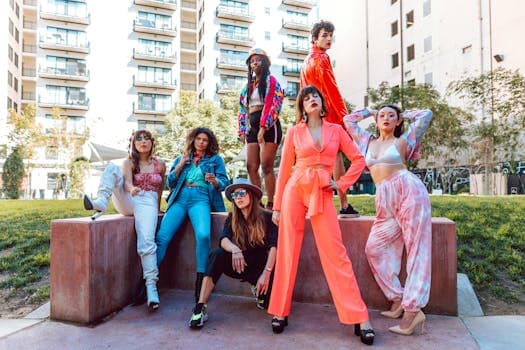Luminous clothing, also known as light-up or illuminated apparel, is rapidly evolving from a niche novelty item to a mainstream fashion trend. Integrating technology with textiles, these garments use various light sources like LEDs, fiber optics, and electroluminescent (EL) wires to create eye-catching visual effects. This blog post explores the exciting world of luminous clothes, covering their functionality, applications, benefits, and future potential.
What are Luminous Clothes?
Luminous clothes are garments that incorporate light-emitting components into their design. These components can be:
- LEDs (Light Emitting Diodes): Small, energy-efficient light sources that can be woven into fabric or attached to clothing. They come in a wide array of colors and can be programmed to create different patterns and effects.
- Fiber Optics: Thin, flexible strands of glass or plastic that transmit light. These are often used to create intricate designs and patterns on clothing. Light is generally generated by an LED and transmitted through the fibers.
- Electroluminescent (EL) Wire: A thin, flexible wire that emits light when an electric current is applied. EL wire is often used to create outlines and accents on clothing.
These technologies are integrated into clothing in different ways. Some garments feature embedded LEDs within the fabric itself, while others have light sources attached to the surface. The power source for these lights is usually a small, portable battery pack that can be concealed within the garment.
Applications of Luminous Clothes
The applications of luminous clothes are vast and diverse, spanning across various industries and interests:
- Fashion and Entertainment: Luminous clothes are a popular choice for parties, concerts, and other events where making a statement is key. Designers have incorporated light-up elements into haute couture and ready-to-wear collections, pushing the boundaries of fashion.
- Safety and Visibility: Luminous clothing plays a crucial role in enhancing safety, especially in low-light conditions. Runners, cyclists, construction workers, and emergency responders can wear light-up apparel to increase their visibility and reduce the risk of accidents.
- Sports and Recreation: Athletes and outdoor enthusiasts use luminous clothes for enhanced visibility during nighttime activities. Light-up running vests, jackets, and accessories are becoming increasingly popular.
- Advertising and Promotion: Businesses can use luminous clothes to create eye-catching promotional materials. Light-up logos and slogans can help brands stand out in crowded environments.
- Medical and Therapeutic Applications: Researchers are exploring the use of luminous clothing in medical applications, such as light therapy for skin conditions and mood disorders.
Benefits of Wearing Luminous Clothes
Beyond their aesthetic appeal and practical applications, luminous clothes offer several benefits:
- Enhanced Visibility: The most obvious benefit is increased visibility in low-light conditions. This makes luminous clothes ideal for anyone who needs to be seen in the dark.
- Increased Safety: By making wearers more visible, luminous clothes can help to reduce the risk of accidents and injuries.
- Unique Style: Luminous clothes offer a way to express your individuality and stand out from the crowd. The designs and patterns can be customized to suit personal preferences.
- Fun and Engaging: Light-up apparel can be a fun and engaging way to interact with technology and fashion.
Potential Challenges and Considerations
While luminous clothes offer numerous benefits, it’s important to acknowledge some potential challenges and considerations:
- Cost: Luminous clothes can be more expensive than traditional garments due to the added cost of the light-emitting components and the manufacturing process.
- Durability: The electronic components in luminous clothes can be sensitive to water and impact, so proper care is essential to ensure longevity.
- Washability: Washing luminous clothes requires special attention to avoid damaging the light-emitting components. Many garments are hand-wash only or require the removal of the electronic components before washing.
- Battery Life: The battery life of luminous clothes can vary depending on the type of light source and the usage pattern. It’s important to choose garments with adequate battery life and to carry spare batteries if needed.
The Future of Luminous Clothes
The future of luminous clothes is bright, with ongoing advancements in materials, technology, and design. We can expect to see:
- More Seamless Integration: As technology evolves, light-emitting components will become more seamlessly integrated into fabrics, making luminous clothes more comfortable and wearable.
- Improved Durability and Washability: Researchers are developing new materials and techniques to make luminous clothes more durable and easier to care for.
- Smarter Functionality: Luminous clothes will become increasingly sophisticated, with features such as smartphone connectivity, customizable light patterns, and sensors that respond to environmental conditions.
- Wider Adoption: As the cost of luminous technology decreases and the benefits become more apparent, luminous clothes will become more widely adopted across various industries and consumer markets.
Conclusion
Luminous clothes represent an exciting intersection of fashion and technology. They offer a unique blend of style, safety, and functionality, making them a valuable addition to any wardrobe. As technology continues to advance, luminous clothes will become even more versatile, accessible, and integrated into our daily lives. Whether you’re looking to enhance your visibility, express your individuality, or simply have some fun, luminous clothes are a bright choice for the future.
